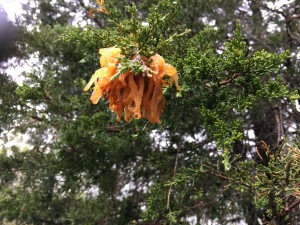Hello fellow readers,
‘It looks like a sea anemone!’ wrote Ruth of Hope referring to the alien-looking bright orange thingy with finger-like protrusions found on a cedar tree. Turns out this two-inch slimy blob is caused by a fungi called Gymnosporangium juniperi-virginianae (wowee; the name is as ugly as the gall!). It’s an infectious organism that causes cedar-apple rust; commonly found where apples or crabapples (Malus) and Eastern red-cedar (Juniperus virginiana) are in proximity of each other.
The lifecycle is fascinating. It starts out causing a reddish-brown gall that grows into what looks like a golf ball with pimples, often construed as a seed pod on the host cedar. After a spring rain, it turns into a bright orange alien gall. That’s when the spores are active and carried by wind to the nearby apple trees. It’s a perfectly timed invasion; just when the apple trees are in the pink or early blossom phase. The spores germinate and enter the leaf or fruit tissue causing infection within a few hours.
Look for yellow leaf spots soon after the bloom. The spots then enlarge turning orange or reddish and later, black dots form. By late summer, tube-like structures develop under the leaf and voila – the spores fly off the apple trees and land back on the cedars. The disease doesn’t spread between apple trees, but passes from cedars to apples then back again. It’s a vicious cycle that defoliates apple trees and disfigures fruit.
They say one of the best remedies is to remove cedar hosts within a mile of apple trees. Easier said than done though as several species of juniper also serve as host. Not to mention quince (Cydonia oblonga), hawthorn (Crataegus) and crabapples that can host cedar-apple rust as well.
There’re resistant varieties of apples such as ‘Red Delicious’, ‘Grimes Golden’, ‘Jonafree’, ‘Winesap’, and ‘Staymans’. Crabapples tend to be more vulnerable but there are resistant varieties too, including my favorite Malus ‘Donald Wyman’.
A fungicide suitable for edible fruit can be applied to apple trees to protect them when the cedar galls are spewing pores. And, you can use the same fungicide in late summer on cedars to reduce infection. Removing the galls before they start flinging spores is effective too. If in the orange alien stage, best to wear gloves. They’re gooey. Garden Dilemmas? askmarystone@gmail.com




